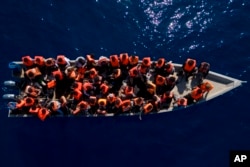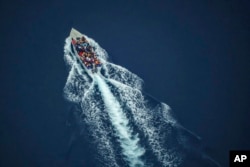Every year, many of the hundreds of thousands of refugees and migrants from sub-Saharan Africa seeking asylum or jobs in Europe are “at great risk of harm and death” because few protection services are available to help them on their perilous journey, according to a report issued by the UN refugee agency, UNHCR, Tuesday.
“The absence of critical services is placing refugees and migrants at great risk of harm and death and is also triggering dangerous secondary onward movements,” Vincent Cochetel, UNHCR special envoy for the central Mediterranean situation told journalists at a briefing Tuesday in Geneva.
“Some refugees and migrants underestimate the risks, while many fall victim to the narratives of smugglers and traffickers,” he said.
The report highlights the horrors faced by refugees and migrants who risk their lives moving on dangerous routes stretching from the East and Horn of Africa and West Africa towards North Africa’s Atlantic coast, and across the Central Mediterranean Sea to Europe.
The UNHCR reports refugees and migrants from about 20 different African countries “die while crossing the desert or near borders.” As well as Sub-Saharan Africans, it says an increasing number of people from countries in Asia and the Middle East, including Bangladesh, Pakistan, Egypt, and Syria are arriving in North Africa.
The report says most of the refugees and migrants “suffer serious human rights violations en route” including ‘’sexual and gender-based violence, kidnappings for ransom, torture, and physical abuse.”
“Protection services along the routes that can help mitigate the risks these people face — such as immediate humanitarian assistance, shelter for people who have been exposed to violence, and access to justice — are often not available,” Cochetel said.
“In many countries, the services that were there in 2022-2023 are no longer there. This is the case, in particular, in Morocco, in Mauritania, in Sudan because of the conflict, in the northern part of Niger, in the southern part of Algeria. So, basically these are in key hubs, key crossing routes that are used by migrants and refugees,” he said.
Aside from the conflict in Sudan, several other crises emerged in 2023 that forced people to flee their homes.
“Regrettably, more emergencies cannot be ruled out in 2024,” authors of the report warn. “Neither can the human need of people to flee or abandon their homes to find safety and or better… basic life conditions for themselves and their families.”
Cochetel observed that the lack of sustained funding threatens the limited services that currently are available, including search and rescue missions.
“In the past, la gendarmerie nationale [the national military police] in Agadez, Niger, would pick up people who had been stranded or abandoned by smugglers and traffickers in the desert. But such rescue missions,” he said, “no longer occur along that route.”
“The only country on the African continent where I know that this concept is implemented is in Djibouti,” Cochetel said.
He said Djiboutian authorities are patrolling the land side of their coast “to see people that have been abandoned by smugglers in the desertic areas or people who have returned with the same smugglers from Yemen and who are dropped in the middle of nowhere,” adding that such search and rescue projects needed to be developed in partnership with local authorities in Nigeria, southern Morocco, Mauritania, and other desert regions.
“We would need that to save more lives and bring back to safety people stranded or abandoned there,” Cochetel said.
Since the publication of the previous report in July 2022, the UNHCR says an estimated 3,045 individuals have been reported dead or missing along the combined Central and Western Mediterranean and Northwest Africa Maritime routes.
“However, the real figures could be significantly higher, as many incidents likely go undetected and remain unrecorded,” it said.
While the report is meant to make governments aware of the shortcomings in support services, UNHCR’s Cochetel said it also is intended to provide useful information on the availability of services for refugees and migrants who are “lost, stranded, and abused along the routes.”
For example, he said the report contains GPS coordinates and WhatsApp numbers that refugees and migrants can use to locate essential, possibly life-saving protective services.


